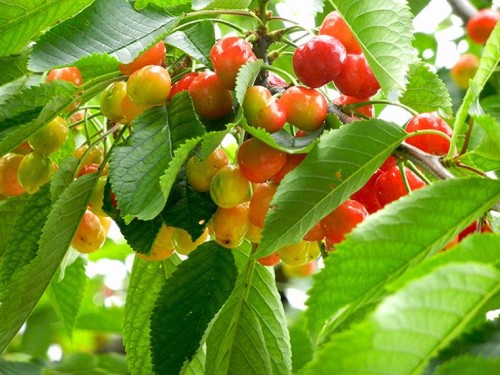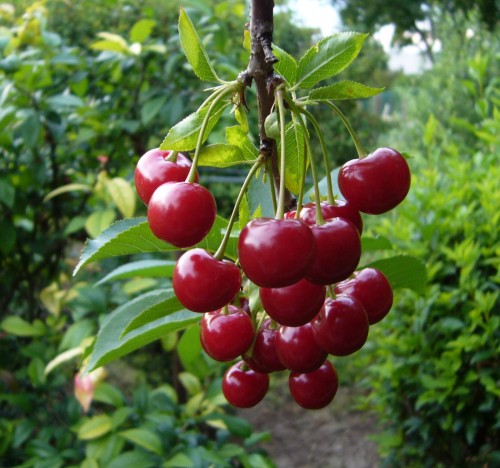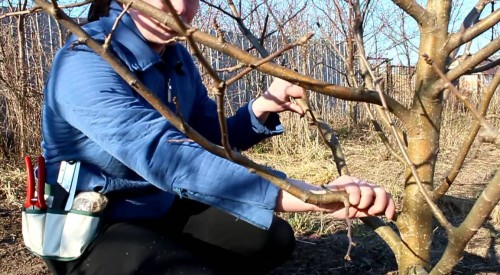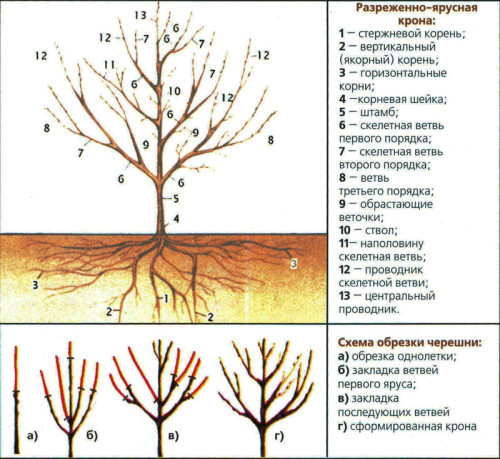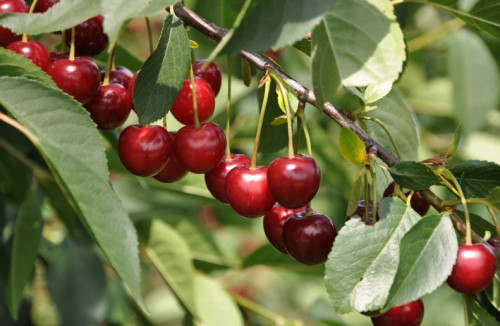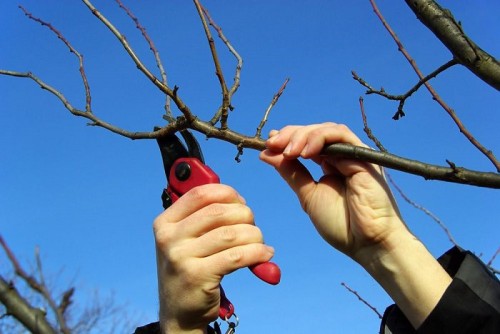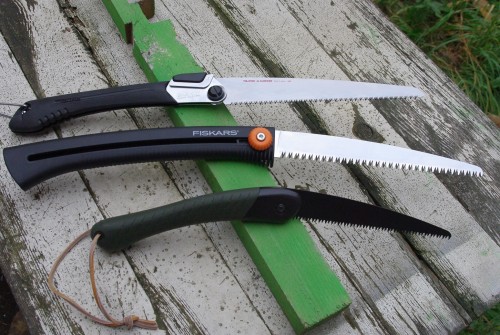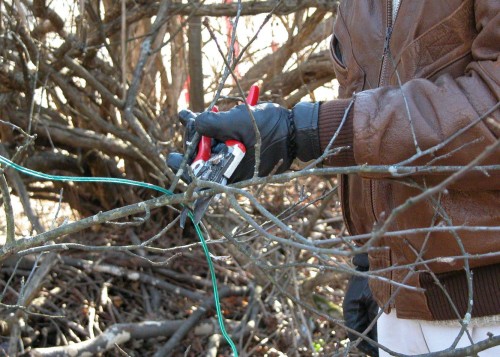The cherry is loved by many for its excellent sweet taste, juiciness and fragrance. Good care for cherry trees will help you get rich yields of berries from each such plant. Care rules include not only watering, dripping and preventing various diseases, but also timely trimming of the branches. In this article, we will tell you how and why to trim cherries in the spring.
Content
What happening cherry
Depending on the age of culture, as well as the purpose of the procedure, several types of trimming are distinguished:
- Forming trimming of young cherries is a process that should be implemented every year. A similar procedure helps to form a tree crown in such a way that the branches are not resolved between themselves and grew evenly, and the crop was abundant and turned well in conditions of sufficient illumination and breathability. Starting the forming trimming follows the first year after planting a seedlings.
- The rejuvenating trimming of an old cherry is needed in order to increase the number of berries. As soon as you notice that the crops on the tree have become not so abundant, with the coming spring it will be necessary to shorten the branches. After carrying out the sherry procedure, it should be similar to a two-or three-year-old tree.
- Trimming the fruiting tree is produced in summer and is suitable for those who could not carry out this process in the spring. Some gardeners adhere to the opinions that the plant weakened after winter is not worth it, as it will harm his health. But if you remove the branches in the summer, a few days after the collection of berries, then the cherry will have time to recover until next year.
Crucifying cherries spend not only in spring or summer, but also in autumn. When choosing the appropriate time for this process, you need to consider the following:
- An early spring is considered to be an early spring for the process of forming a crown. In the first weeks of March, when the kidney does not yet swout on the tree, and the process of the Softness has not yet begun, the injured places on the wood will be delayed faster.
- Protecting sanitary destination is carried out in the fall. Removing the dried, damaged and sick branches from the tree, you save the plant from excess cargo and prepare it for winter cold.
- Drawing cherries in the winter season is extremely not recommended. The constant effect of low temperatures makes a tree fragile, and cutting it, you risk getting unnecessary cracks and damage to branches. Such damage is tightened for a very long time, and various infections can fall into open sections.
- Summer pruning is relevant if you want to remove damaged or broken branches, as well as extra shoots that grow inward crowns and creating unnecessary thickens.
Crucifying cherries should be carried out every year, since young branches grow enough intensively. When the young plant begins to be fruit, you can cut the central conductor. Thus, the side branches will develop faster, releasing new shoots and giving the opportunity to collect abundant yields. The branches whose growth is directed into the crown, you need to delete. Also, it is not necessary to make an occurrence of sharp development on the cherry.
Common bugs in the formation of a cherry tree
- If you are young, just planted seedling to cut at a level of more than 1.2 m, the skeletal branches of the first two orders will be too high. In the event that Krona starts to develop at a level of more than 1.5 m, the fruction zone will be located even higher - at 2 m. This will complicate the process of collecting berries, and subsequent trimming will negatively affect the crop yields.
- If the skeletal branches of the second and third orders will be laid too early, and the branches of the first tier will not be strong enough, the first tier will move over time with time and the crown above. As in the previous case, the treatment of the tree and the process of collecting berries will be difficult.
- In the case when the branches of sweet cherry are cut too short, fruit kidneys are laid on the shoots, increasing the number of growth processes.
- Leave branches too long is also not worth it, as they will not give yields. Long shoots are recommended to shorten any less than twice.
Subtleties trimming cherry trees
The sweet cherry refers to those cultures whose shoots grow quite intensively, but at the same time weakly branched. That is why the formation of the crown of such a tree is not a task from the lungs. Let's look at the main features of cherry trimmed:
- So that the crown of the tree was the right form, had a compact size and sufficient lug, starting the forming trimming follows the first year after the seedlock was moved to a permanent place.
- The procedure is carried out before the competence period. Making pruning, it is desirable to pay more attention to thinning the crown, and the length of the shoots is adjusted moderately.
- On the crown of the tree, if possible, there should be no sharp fork. If a young escape is growing next to the fruiting branch, located under an acute angle, it should be separated using cargo or tie to the branch growing below. If you do not do this in a timely manner, then the fruiting part of the tree can break.
- For elderly trees, it is important to carry out regular rejuvenating trimming. It should be carried out at least once every 4-5 years.
Trees trimming process
Forming trimming of cherry
As mentioned earlier, the forming trimming is important for the proper formation of the crown and creating favorable conditions for the growth and fruction of the tree. If you carry out the trimming correctly, ultimately you should get a crown consisting of 6-8 skeletal branches of the first order, half of which will be in the lower tier. The branches of this level should be positioned not on each other, but from different sides of the trunk. The upper tiers should grow by 55-60 cm above the first level, and the distance between the shoots should be about 45-50 cm.
You can find the Spring Spring Cruise Scheme on the Internet, and we will give a detailed description of this process by year:
- In the first spring after disembarking a young sapher, the height of the strain should be noted on it, then measure 4-6 kidneys upwards and produce trimming at this level. The height of the stan can be different: from 30 to 60 cm.
- A year later, when the tree gives young shoots, you should select several branches from them, which will serve as the first level of the skeleton. 3-4 Branches of the lower tier must be located from different sides of the trunk. Then they are cut off, leaving the length of about 50-60 cm. Measuring from the upper escape approximately 60-65 cm up the trunk, you need to count 4 kidneys and cut the conductor at this level.
- With the onset of the third spring you need to hold a new stage of forming trimming. The lowest branch, which, as a rule, remains not well developed, leave as it is. Top shoots shortened to the level of the lower bitch. If some sprouts have formed a sharp angle in relation to the skeleton, cut them. The same needs to be done with those shoots that sprouted the crown inside. After that, it is possible to be taken for the formation of second-order skeletal elements. Recover strong severe blesses, cut from the conductor at least 30 cm. Then cut them so that they are shorter than the growth of first-order branches by 15 cm. Over the upper escape of the second tier, measure 45-50 cm on the barrel and cut the sterling over 4-50 cm. 6 kidney. Among the branches of the second tier, take 1-4 pcs. And shorten them in such a way that they are less than the length of the conductor for 20 cm.
- With the onset of the fourth spring, the trimming is carried out in the following way: the central conductor is shortening over a weak side branch, and the last cut to the size of 50 cm. The shoots of the third tier must also be shortened, so that their length is less than the length of the conductor for 20 cm. In the event that the besses of the third The tier is too short, they, together with the central trunk, should be trimmed in the place where the thinnest spinning of the third level begins to grow. The branches of the first two tiers should be cut up to length 70-75 cm. If they have not yet reached the desired indicator, they are left as it is. To avoid crown thickening, all growing branches need to be removed. The shoots directed to the outside should shorten up to 70 cm or not touch if they have not achieved such lengths.
- On the fifth and sixth year, cherry trimming is carried out in the same way as in the fourth spring. Branches whose length exceeds 50 cm, cut off. The shoots flying between themselves or directed by the crowns are removed. Short branches are left in pristine form, removing only those that grow under an irregular angle. On the central trunk, strong elongation shoots and translate them to short side branches.
Rejuvenating cherry trimming
This procedure must be carried out with all old trees to extend the term of their fruiting and increase the number of berries. During the rejuvenating trimming, old, patients and non-pronomous branches are cut, forming a new crown plant. They are engaged in such a work every 4-5 years, carrying out the process only after the end of all spring frosts. If spring was turned out to be cold and rainy, the procedure is transferred for the first weeks of June. The rejuvenating trimming can not be carried out in the fall and at the time when the tree is at rest. With such a trim, it should be getting rid of older bans, the age of which exceeds 6 years. All wounds and damage must be treated with a garden harder, so that the cherry is restored faster.
In the last weeks of May, young branches, the length of which is at least 15-20 cm, can be discharged at growth points. In approximately in June, young shoots are shortened to a length of 30-40 cm.
Pruning is sweet during fruiting
The formation of the crown of a young tree lasts 6 years, after about the same time the cherry begins to give abundant yields, and it is limited to maintaining the correct height and shape of the tree. The trunk of fruitless cherry must be trimmed at an altitude of 3-3.5 m, and the length of the skeletal branches to maintain at 4 m. Young twigs growing inward crowns, as well as broken, damaged and sick shoots should be deleted in a timely manner.
Tips for proper trimming trees
- It is possible to start the spring trimming of trees only when the last frosts will be completed. This time, as a rule, falls on the first 2-3 weeks of March. Work can be continued until the kidney fell on the plant.
- If you have trees of different ages on your site, then begin to process more adult cultures. Often it is on such trees kidney swell earlier.
- Most crown plants are formed for 8-12 years. Throughout this time, it is important to carry out constant adjustment of the shape and height of the tree, as well as remove unnecessary and sick shoots.
- The branches from which you form a skeleton should be an angle with a barrel of at least 40 °. In the process of creating the crown, the most durable, thick and strong bows should be selected. In addition, the branches must be successfully located relative to each other.
- Branches growing at one level must be defeated from each other about ¼ of the trunk circle. The even the shoots will be located - the better the crown will be formed. Proper illumination of all parts of wood, as well as good air circulation between branches - the key to successful growth and rich yields.
- Creating a crown, between the branches of the first order, you can leave half-plated branches for a while. They are constrained from active development by constant trimming, and when the plant will become quite adult and strong, such branches are gradually removed.
- The second order skeleton is formed from the processes located on the right and left side of the uterine branch. Those shoots that are directed inward or outward crowns should be cut off.
- The shoots growing on one bitch should not go beyond the limits of their sector and interfere with the shoots of the neighboring bitch. During trimming, the branches give the right direction, so that they grow fanlikely.
- All shoots whose growth is directed to the crown or towards each other, as well as the intersecting branches must be deleted.
- Negative phenomenon is the deception of branches, i.e. Their tallness on a rather long section. Cool bitterness produces a small number of second-order shoots, it is weak and unstable, can break under the weight of ripened berries. Such branches give a bad harvest and make it difficult to care for cherries. To get rid of hellishness, you should shorten a strong annual increase - this will help to get new branches located at the base of skeletal branches.
- When forming the crown, it is impossible to make the occurrence of acute forklog, the angle of which is less than 40 °. A similar phenomenon may occur when the main and secondary branch develop equally quickly. In such developments, the sharpness of the borties are fragile, after a certain time, the branches can simply break. To avoid the occurrence of sharp corners, during the selection of skeletal bans you need to cut the "ring" side processes, the angle of which with a royal branch is less than 40 °.
- To find out how short one branches should be crossed, focus on the weakest blesses. As a rule, branches growing at the top of the crown are most shortened. The lower tiers and weak branches are cut quite a bit or not cut at all.
- In the event that there is only one weak branch on the tree, and the remaining processes are quite strong, when trimming, weak bitches are not taken into account.
- Skeleton shoots need to shorten over that kidney, a new branch of which will grow in the direction you need.
- So that the cherry has not grown too high, after complete formation of the crown, cut the conductor over the upper branch of the skeleton. In subsequent years, remove all processes that appear on this bitch and sent to the Crona Center.
Ways trimming branches
Work tool
Any gardener will be easier and easier to work if he has all the necessary tools at hand. Special devices for trimming trees can be attributed:
- Cepping. To work in the garden, you need to select a convenient and simple tool, so that in the pruning process I had to make as little effort.
- Garden hacksaw, which has special teeth, in which sawdust is not stuck. Gardening hacksaw has a special form and is directed at a certain angle, which ensures convenience. But the ordinary building tool for trimming the garden will not fit.
- Aerial secateur is a device needed to work on remote and highly located branches.
To apply as little damage as possible, only well-sharpened devices should be used, in addition, it is necessary to monitor their cleanliness. If we trigging stupid blades, the sections will turn out uneven and ribbon - infections can get into such wounds, and the tree will begin to root. After processing each plant, it is necessary to clean the tools and wipe the woven cloth.
To protect the tree from pathogenic microorganisms and parasites, the sections need to be lured by the garden water, olifa or oil paint.
Technique trimming branches
Depending on what result you need to achieve, when trimming, gardeners use several different techniques:
- A cut on the kidney allows you to adjust the direction of escape growth in the desired side. To make a cut on the kidney, select the one-year branch and find the kidney on it located in the desired direction. Taking the secret to the secret, attach it to the bitch so that the blade was turned to the part of the tree you want to leave. Cutting the branch, do it under a small angle. As a result of the work done, the kidney should remain the whole, and there should be no hemp over it. Too sharp corner of the cut will lead to the fact that the kidney dries away from the lack of nutrition. If you leave a large funeral, the kidney may not wake up.
- The ring on the ring is carried out in the case when the need to remove the whole bitches. Such a procedure is used when you need to cut a branch growing inward crowns. A thin escape can be removed using a secaterator, and for a thick bitch it is better to use garden hacksaw. The cut should be carried out at the outer edge of the ring - it is located in the places of the blows of the two branches and looks like a kind of roller.
- Side on lateral branch is used when it is necessary to translate the growth of one escape to another. As a result of such a procedure, one of the branches is cut off, and the slice is a continuation of the second branch. As a rule, in this case, the main branch is removed, and the secondary takes her place.


